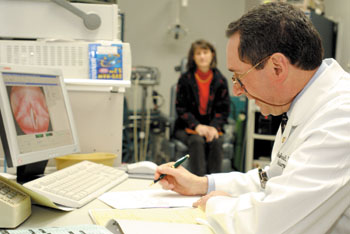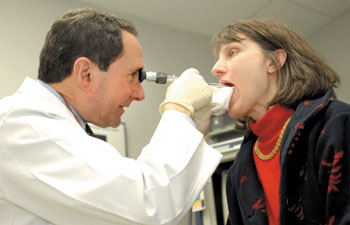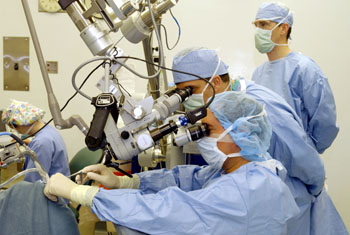
Mary Anne Hoskins kept her problem in the background for two years. At the Vanderbilt Voice Center, Dr. Robert Ossoff’s team removed polyps from her vocal fold, helping restore her voice.(photo by Anne Rayner Pollo)
Finding a voice — Surgery, therapy, research put Voice Center above the bar

A pre-op visit affords another look. The polyp is still there. (photo by Anne Rayner Pollo)

Peering through the microscope, Dr. Robert Ossoff removes the polyp and Dr. John Sinacori, a fellow in laryngology, looks on. (photo by Anne Rayner Pollo)
Mary Anne Hoskins is sitting in Melanie Hudson’s office, blowing raspberries.
She’s learning how to use her voice. At 44, she thought she already knew. But one look at her vocal cords and Dr. Robert Ossoff sent her down the Vanderbilt Voice Center hallway to Hudson, a speech pathologist, who soon put Hoskins through the training paces. Hoskins pursed her lips and buzzed, she talked into a Kleenex, then she emitted a very dramatic “hummmmm” in a great arpeggio arch, like a note going over a waterfall.
Hoskins, an academic advisor at the University of Tennessee, started losing her voice about three years ago when, as an alto in the Knoxville First Baptist Church choir, she noticed her hallelujahs were harsh and inharmonious. She saw her physician, who referred her to an otolaryngologist, who suggested surgery.
Normal fears arose about having someone operate on her throat, on the only voice she has. “It shocked me. I wasn’t prepared for it, and I really wasn’t open to it,” she says.
She let it sit for a year, then saw a different otolaryngologist, who referred Hoskins to Vanderbilt. “She felt like this was the best place,” she says. Friends recommended Ossoff as the only one they would trust with their voices, and her worries ebbed. She came in two weeks ago for an initial appointment and a stroboscopy—a high-tech video of her vocal cords in action, taken at 100 to 1,000 frames a second. Today, Ossoff and laryngology fellow Dr. John Sinacori explain the surgery she’ll need in two more weeks.
The cords lie in the larynx like a pair of curtains hanging over the trachea. They serve two purposes: to close the airway when we swallow so food doesn’t go down the windpipe; and to vibrate like the tines on a tuning fork to produce sound.
Since his arrival in 1986, Ossoff, director of the Vanderbilt Bill Wilkerson Center for Otolaryngology and Communication Sciences, Guy M. Manness Professor and chair of the department of Otolaryngology, has built the specialized Vanderbilt Voice Center around treating these tender folds of tissue and other disorders of the larynx.
Dr. Mark Courey was the department’s first laryngology fellow in 1992. Now, he is an associate professor of Otolaryngology and the Center’s medical director, seeing professional voice patients and adults with general voice or airway disorders. Dr. Gaelyn Garrett came as a fellow in 1994. She’s also an associate professor of Otolaryngology and sees professional voice patients and pediatric patients.
When Garrett was shopping around for post-resident training, Vanderbilt offered one of only two such fellowships in the country. Now, due in part to Vanderbilt’s contribution, the subspecialty is growing and becoming more competitive, she says. Several programs were available to Sinacori and his co-fellow, Dr. Jonathan Workman. (When they leave this summer, Ossoff will have trained 20 fellows; 15 of them have returned to academia.) But none offer both the volume of patients or the breadth of work at Vanderbilt, Sinacori says. “Seeing patients is the best experience, the best way for us to learn,” he says. “Here, there are enough patients to keep three (faculty) clinicians busy.”
Diversity of clinicians also sets the Center apart, and helps assure complete treatment. “The Voice Center was the first, and is one of the few truly multi-disciplinary voice clinics where we all work as a team,” Garrett says. “We’re not limited to one physician, one speech pathologist and one vocologist.”
The Voice Center is stocked with a complete complement of specialized clinicians. In 1987 Ed Stone, Ph.D., became the Center’s first “vocologist.” He retired in February. Tom Cleveland, Ph.D., a professional singer-turned professional voice clinician, joined the faculty in 1993 and is acting director of vocology. Hudson and five other speech-language pathologists, each with their own special focus, from age-related voice problems to singing therapy, see patients such as Hoskins, and immediately set them on a path of healing with education and therapy from the beginning to the end of treatment.
The walls of the Voice Center tell part of the patient story. Platinum and gold record albums, framed and personally signed by scores of recording artists from Johnny Cash to Broadway singer Grant Norman, line the walls.
“The entertainers have really put the Voice Center in the public domain,” creating exposure and adding high-profiled credibility to the Center’s reputation, Garrett says.
But only about 20 percent of the patients are professionals, and include waitresses awaiting their big breaks, Broadway tour performers passing through town and professional speakers, from ministers to motivation mavens.
Hoskins and others, whose voices are just as important in their workaday lives, without being their lives’ breadwinner, constitute the bulk of encounters. “Most of our patients don’t have their pictures on the walls,” Garrett says.
Each Friday Garrett and Courey see an influx of these non-celebrities in a Botox clinic. The drug, derived from botulinum toxin, helps calm the interruptions of spasmodic dysphonia, spasms of the muscles that control the vocal cords and result in interrupted speech that sounds as if it’s being belched.
The injections are the only option to surgery for these patients, she says. And while surgery, which involves cutting the nerve to the vocal cords, is irreversible, the drug provides symptomatic relief by relaxing the nerve and controlling the spasms, sometimes for months. “And you’re not burning any bridges,” Garrett says.
About 20 patients come to the clinic each week. “We’re one of the three busiest clinics, in terms of volume, in the country,” Garrett says.
And then there are the nodes, nodules, cysts and polyps—bumps that appear on vocal folds usually as a result of improper or inefficient use of the voice, such as talking too much or too loudly, or talking with an affected or strained voice.
Hoskins, by her own admission, is a talker. And her job requires constant discourse with students on career advice and presentations to faculty and staff. And, of course, she sings in the church choir—or used to.
The first stroboscoby revealed a polyp on her left vocal cord. Today, Sinacori took another and has pulled the images up, side by side, on a computer screen. There’s little difference. It’s a volcano-red dot on a bed of normal, soft-looking pink tissue. On the screen, it looks huge, but, Sinacori says, it’s about as big as the point on a ballpoint pen, and it’s practically brought her voice to a standstill.
Ossoff confirms the diagnosis and suggests surgery. He explains the procedure and its risks, and fields Hoskins’ questions. Then sends her with Hudson so she can begin prepping her voice.
The polyp, Hudson says, is an organic problem with a behavioral cause. It results from too much tension around the voice box. “Air flow, not muscle action, makes the vocal cords vibrate,” she says. “You can’t squeeze with your muscles and let air out at the same time.”
She tells Hoskins to concentrate on feeling a “nasal resonance.” To do so, she has to form the tones in her upper airway, around her nose, instead of straining the muscles around her larynx. She instructs Hoskins to hum and blow out through her mouth at the same time, and Hudson holds a Kleenex in front of Hoskins’ face. If she’s doing it right, the Kleenex moves. But it’s not as easy as it sounds, and it takes Hoskins a while to first realize what she’s doing wrong; it’s a bad habit grown comfortable, except for the tightness in her throat. It takes another few seconds to get it right, but it’s still not very strong. So Hudson has Hoskins lean over, bending at her waist, and rest her head against the back of a chair. This is supposed to help her relax her throat and let the air flow from her diaphragm to her nose. A couple of embarrassing moments later, and she gets it. Another try with the Kleenex, and she’s learned her lesson.
Next comes the hardest instruction: to keep quiet until the surgery.
Two weeks later she’s in for a pre-op visit. Sinacori and Ossoff check to make sure they’re on track. Then speech pathologist Molly Kilgore takes voice measurements, having Hoskins talk into a special tube hooked up to a computer, emitting sounds for as long as she can and as loudly as she can. The Center collects this data on every patient, pre-op and three months post-op, to measure outcomes.
Ossoff, Courey and Garrett helped spur the evolution of vocal cord surgery, from radical procedures that removed much of the tissue, through the use of lasers to the current method, a micro-flap.
“Years ago we used to teach using a laser for the procedure,” Ossoff says. But the laser caused too much collateral damage. “Now, we lift up the mucosa as a flap and put it back into place when we’re finished.”
Sinacori describes the procedure to Hoskins: “It’s like pulling down the bed covers, removing a lesion in the sheets and then folding the covers back over the top.”
In the OR, Ossoff feeds tiny instruments on long sterile stems through Hoskins’ mouth, peering through a microscope. Video monitors display the larynx and its vocal cords in full color, the polyp, with blood vessels feeding it from above and one draining it below, looking as big as a baseball. But Ossoff controls the tools with the slightest movement of his fingers. Precision is a tenth of a millimeter to a few millimeters. There‘s tight coordination on the exchange of instruments from scrub nurse, Amber Wallace, R.N.
Once he’s in and able to move the tissue around, Ossoff finds another polyp, this one on the right vocal cord. With a CO2 laser he dries up the vessels to isolate the blood supply. With scissors, its blades no longer than eyelashes, he cuts elliptically around the lumps, cuts the lumps free and extracts them. Then, as Sinacori described, Ossoff lays the tissue back together.
The surgery’s success depends on the total team approach, Ossoff says, from the high-tech diagnostics to speech pathologists’ lessons to the OR crew’s experience. And still, he says, there’s more to come.
“For all of the delicate microsurgery, we totally rely on the speech pathologists to heal them.”
And if Hoskins wants to graduate beyond blowing raspberries, part of the work will be up to her. She’ll need one to two weeks of complete voice rest, and then gradually increase the time she’s allowed to talk for a month until she’s back to full conversational levels. Speaking-voice therapy continues for two months post-op. By then, Hoskins’ hum will burst into song.
“I hope when I finish therapy, that when I speak my throat will be stress-free, that I won’t get hoarse,” Hoskins says. “But mostly I want to sing. To the radio, to myself at home. When I turn on music, I just want to sing.”













